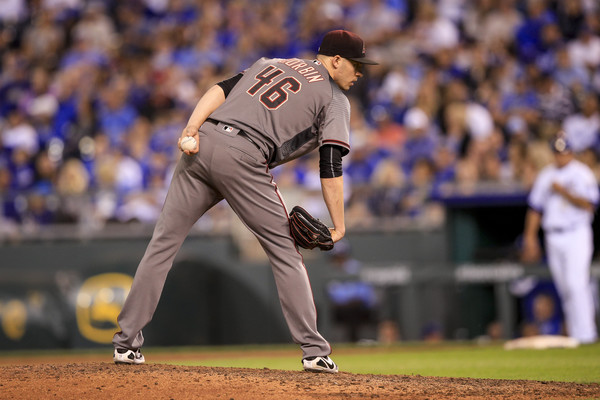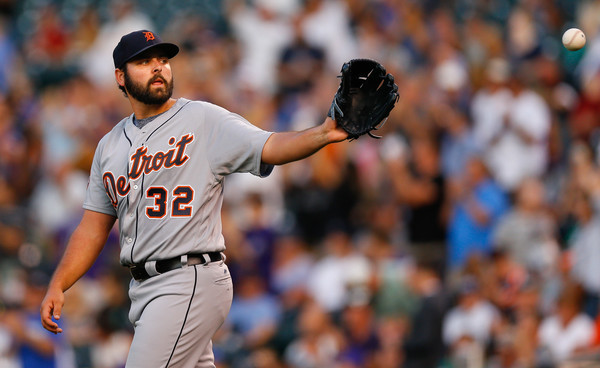
Stop me if you’ve heard this before, but the Yankees are looking for pitching. It’s shocking, I know, but it’s going on. Even though they ‘found’ a pitcher yesterday by re-signing CC Sabathia to a one year, $10 million contract, it’s unlikely that they’ll just settle in with what they have. Sure, a rotation of Luis Severino, Masahiro Tanaka, Sonny Gray, Sabathia, and Jordan Montgomery is solid, but that doesn’t mean they can’t and won’t add to it. We’ve seen the Yankees connected to free agent Alex Cobb a bunch of times this offseason. However, most of the buzz around the Yankees and pitching seems to be concentrated around the trade rumor mill.
Over the past two weeks or so, the Yankees have been linked to no fewer than four starting pitchers in trade rumors. One is division rival Chris Archer of the Rays. Another, also in the AL is Tigers’ starter and 2016 AL Rookie of the Year, Michael Fulmer. The other two hail from the National League–Gerrit Cole of the Pirates, the Yankees’ first round draft pick in 2008, and Patrick Corbin off the Diamondbacks (who became an absolute monster in one iteration of franchise mode in The Show for me many moons ago).
When considering a trade, we’ve got a multitude of factors to weigh, but they can be boiled down to three fundamental categories: cost, control, and performance.
Cost operates on two fronts: How much money and how many players will it take to get your target? Control considers the player’s current contract and that/those of the player(s) you’re giving up. And performance deals, of course, with whether or not the guy is any good or has done well. All three categories can and will intersect when evaluating whether or not to make a trade.
To bring work home with me even more than an English teacher already does, I developed a quick rubric of sors to judge each trade candidate using the aforementioned fundamental categories.
| Category/Score | 3 | 2 | 1 |
| Cost $ | Low $ | Medium $ | High $ |
| Cost player | Low player | Medium player | High player |
| Control | 3+ years beyond 2018 | 1-2 years beyond 2018 | Impending free agent |
| Performance | High performance consistently AND recently | Some inconsistencies, may be a rebound/regression candidate | Consistently poor performance |
For the acquiring team, you obviously want the cost to be low and the control and performance to each be high. The better that combination, the more desirable the trade target. Let’s use Giancarlo Stanton as a test case or model to implement this rubric. We have hindsight here and in a vacuum, without the Marlins’ apparently dire financial situation, Stanton would be high on all three categories. He’s got a big contract for a long, long time, and just won NL MVP; in a “normal” world, he would’ve cost an arm, a leg, and then some. But, in reality, Stanton was acquired for a low player cost and even the big cost of his contract–which has him under control for a long time, a double-edged sword, perhaps–is somewhat mitigated by the Marlins kicking in $30 million. By any rubric or measure, this was a no brainer trade for the Yankees to make.
Let’s lead off by looking at Gerrit Cole, the pitcher most consistently linked to the Yankees recently. Cole is projected by MLBTR to make $7.5 million in 2018. That’s not bad at all. Additionally, he’s also under control for 2018 and 2019. The former puts him at a 3 for Cost $ and a 2 for control. Not a bad start. The player cost is where we hit a bit of a bump or a snag. Yesterday, it got out that the Pirates were going to ask for Gleyber Torres in exchange for Cole, which is, uh, not gonna happen. Good for them for asking, but I’d sooner bet on the snowball in hell. Failing Torres, though, it’s likely the Pirates will then ask for Clint Frazier and more–Chance Adams, perhaps, and another lesser piece. At first blush, that seems to be the going rate for a pitcher of Cole’s reputation, so that could just be the cost of doing business, right? You’ve gotta give to get and all that, and if both sides are hurting, then the trade is probably good. But Cole seems to have more in the bank on reputation than on performance lately. He was downright elite in 2015 but then just sorta good in 2016–and hurt–and pretty meh overall in 2017. He had a big home run spike last year–his HR/FB% more than doubled from the year before–which could explain a lot. But when you’re poised to give up someone as talented as Clint Frazier and a potential league-minimum, back of the rotation guy in Chance Adams, AND another piece, I’d want something more than a guy who’s pretty much the definition of a 2 on my rubric. The idea of Cole seems to be better than the reality.

Starting with the money, we get another manageable situation in Diamondbacks lefty Patrick Corbin. He’s projected to make $8.5 million. Another 3 in the Cost $ category. Where he loses out, though, is that this is his last year of team control and he’s a free agent at the end of the year. Big time 1 in the Control category. That would likely bring his player cost down, too, as would performance that was okay-ish in 2017 (4.03 ERA, 4.08 FIP), his second full year back from injury after missing all of 2014. 2016, by the way, was pretty ugly for Corbin (5.15 ERA, 4.84 FIP). What stands out is a garishly high HR/FB% of 15.8% last year; his career mark is 13.8%. Granted he plays in a homer friendly park, but that wouldn’t be likely to move down in Yankee Stadium and the AL East. If I’m feeling generous, I give him a 1.75 in the Performance category and probably a high 1, low 2 for player cost. Overall, I don’t think this one would be worth it unless that player cost dipped way down low.

Chris Archer is a pitcher who, on the face of things, passes every mark for a Yankee trade target. He’s got a good reputation and has spent his entire career in the AL East. Beyond that, he’s got a team friendly contract that has him making $6.25 million in 2018, $7.5 million in 2019, $9 million in 2020, and $11 million in 2021; the latter two are club options with buyouts of $1.75 million and $250, 000 respectively. That all makes for a fantastic mark in both Cost $ and Control. Unfortunately, that also means he’d likely be a 1 in Cost Player. Add on the fact that the Yankees would be trading with a division foe and you’re looking at a very steep cost. In terms of the Performance category, Archer is sort of in the same territory as Gerrit Cole; based on the way we think and talk about him, you’d think his stats would be a lot more glowing. While he hasn’t been bad by any real stretch, he’s failed to repeat the great season he had in 2015. A big home run spike in 2016 and 2017 is likely the cause of that. Still, he throws lots of innings (200+ the last three seasons), strikes out lots of guys, and doesn’t walk a ton of batters. Throw in that with the with the contract and this is someone who, unlike Cole, I could see giving up some top-flight talent for.

Michael Fulmer is about to start his third year of MLB service, so his first shot at arbitration won’t be until a year from now. Per Cot’s , Fulmer is also going to qualify for Super 2 status, meaning he’s got an extra year of arbitration, giving his team control of him through 2022. Hot damn. That’s a 3 and then some on the Control category. Even if he signed some sort of extension or contract, his mark in Cost $ is going to be a 3 pretty much no matter what. In terms of performance, Fulmer more or less repeated his ROY season, though with a lower strikeout rate. He kept up a big ground ball rate, though, and did a good job of keeping the ball in the park. That would probably change in moving from Comerica Park to Yankee Stadium, of course. Still, he’s got good control and command and keeps the ball on the ground; if you’re not going to strike people out, those two are the next best things. All this, though, of course means that Fulmer’s player cost is going to be sky high. The Tigers would be justified in asking anything–non-Torres division–in exchange for Fulmer. While there would be doubts in my mind about paying the player cost for Cole and some minor ones in paying the player cost for Archer, those more or less don’t apply to Fulmer. A young, supremely controlled pitcher with history of solid performance? Yep.
Given all this, my preferred order of acquisition would look like this:
Fulmer, followed by Archer, then a toss up between Corbin and Cole. While Cole is definitely the better pitcher, the cost for Corbin would likely be a lot lower, which evens them out a little bit. I’m not sure, obviously, what’s going to happen, but if the Yankees are going to go hard for one of these guys, it should be Fulmer. The farm system would take a hit and it would suck to say goodbye to someone as fun and cool as Clint Frazier, but Fulmer would make an immediate impact and a lasting one.
Leave a Reply
You must be logged in to post a comment.